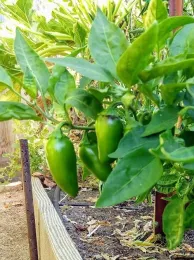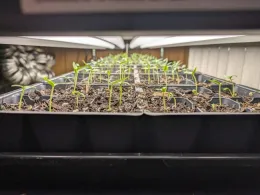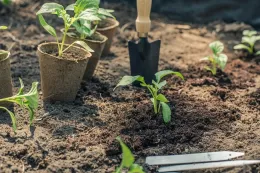Growing Peppers from Seed: Part 2 – Potting Seedlings, the Hardening Process, and Transplanting to Your Garden

Potting the Seedlings
Plant each seedling into individual larger containers with potting soil to give them plenty of room to grow larger. Any type of pot with a drainage hole will do. Continue to keep them warm and watered from the bottom, with adequate light each day, along with the oscillating fan discussed in part one. Keep them in the pots for at least a week.
Pepper plants dislike cold, so they could die if moved outside into your garden too early. It is best to wait until all chances of frost are gone and the soil has warmed up. In our area that is usually between the end-of-March and early April.
“Hardening Off” is an Important Step!
The seedlings are used to an indoor environment where there is no rain, wind, or direct sunlight, so they need to be toughened up prior to transplanting them to your garden outside. This is called “hardening off” and is a crucial step that cannot be skipped if you want to have healthy, producing pepper plants.

The hardening process can begin when daytime temperatures are consistently above 60°F and 7 – 14 days prior to the day you plan to transplant the seedlings to your garden:
- During the first couple days move the pots outside to a sheltered, shady spot such as a covered patio. Choose a mild weather day that is not windy or has a storm forecast. Leave them outside for two hours and bring them back inside under the grow lights. Over the next few days, gradually increase the time the plants spend outside in the protected area.
- Move plants out from the sheltered area. Again, start at just a couple hours per day, then over five – seven days gradually increase the length of time your plants are exposed to the sun. Do this during the morning or evening hours since afternoon sunlight could burn them. Gentle rain and light winds during this time will help the plants get used to the elements but move them back to protected shelter as needed if extreme weather occurs.
- The plants will dry out faster outside, so check regularly and water as needed, which could be more than once a day. They can get slightly dry, but do not let them dry out to the point of wilt.
- Once your seedlings have been outdoors all day and the temperatures are consistently above 50°F at night, you can leave them outdoors during nighttime as well. But they will still need to be protected from high winds and storms.
Planting in the Garden!

Do not overfertilize. Peppers are light feeders but will benefit from a regular feeding of a well-balanced organic fertilizer. Avoid high nitrogen fertilizers.

Peppers are slow to mature, so depending on the pepper variety, when you planted them in your garden, and the weather, you should be able to reap the rewards of your labor between July and September! Enjoy!
Author: Denise Godbout-Avant, UC Master Gardener since 2020
